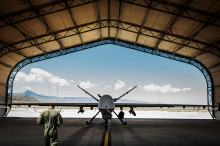Union General William Tecumesh Sherman famously said, “War is Hell.” I think few would dispute that claim.
For millennia armies have battled each other in bloody engagements. Hand-to-hand combat during the days of the Greeks and Romans wasn’t that different from that of soldiers in World Wars I and II, or even this century, with U.S. Special Operations forces fighting in Iraq and Afghanistan – and elsewhere.
We – especially the United States – have looked to technology to keep our warriors out of harm’s way. Nowhere is this more prevalent than in our use of armed unmanned aerial systems – “drones” to take out enemy combatants.
But far from being easy and “antiseptic” this missions have had often-severe consequences for the men and women he operate these drones.
This issue was perhaps addressed best in a powerful article – a New York Times Magazine cover story – entitled: “The Wounds of the Drone Warrior.” Here’s how it begins:
In the spring of 2006, Christopher Aaron started working 12-hour shifts in a windowless room at the Counterterrorism Airborne Analysis Center in Langley, Va. He sat before a wall of flat-screen monitors that beamed live, classified video feeds from drones hovering in distant war zones. On some days, Aaron discovered, little of interest appeared on the screens, either because a blanket of clouds obscured visibility or because what was visible — goats grazing on an Afghan hillside, for instance — was mundane, even serene. Other times, what unspooled before Aaron’s eyes was jarringly intimate: coffins being carried through the streets after drone strikes; a man squatting in a field to defecate after a meal (the excrement generated a heat signature that glowed on infrared); an imam speaking to a group of 15 young boys in the courtyard of his madrasa. If a Hellfire missile killed the target, it occurred to Aaron as he stared at the screen, everything the imam might have told his pupils about America’s war with their faith would be confirmed.
The infrared sensors and high-resolution cameras affixed to drones made it possible to pick up such details from an office in Virginia. But as Aaron learned, identifying who was in the cross hairs of a potential drone strike wasn’t always straightforward. The feed on the monitors could be grainy and pixelated, making it easy to mistake a civilian trudging down a road with a walking stick for an insurgent carrying a weapon. The figures on-screen often looked less like people than like faceless gray blobs. How certain could Aaron be of who they were? “On good days, when a host of environmental, human and technological factors came together, we had a strong sense that who we were looking at was the person we were looking for,” Aaron said. “On bad days, we were literally guessing.”
Want more? You can read this powerful article here


